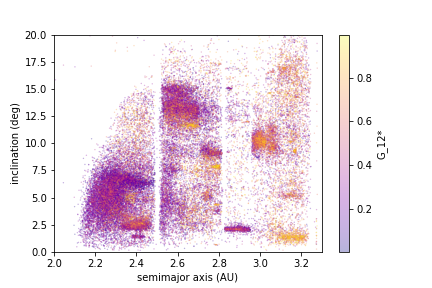- 1Astrophysics Research Centre, School of Mathematics and Physics, Queen’s University Belfast, Belfast BT7 1NN, UK
- 2Institute for Astronomy, University of Hawaii, 2680 Woodlawn, Honolulu, HI 96822, USA
- 3School of Physical and Chemical Sciences – Te Kura Matū, University of Canterbury, Christchurch 8140, New Zealand
INTRODUCTION
The Asteroid Terrestrial Last-impact Alert System (ATLAS) currently consists of two robotic telescopes in Hawaii. Together they scan the entire visible night sky every two nights in wideband orange and cyan filters down to ~19.5 mag. In addition to rapid discovery and follow up of Near-Earth Objects, ATLAS serendipitously observes a large number of asteroids and other moving objects. Since operations began in 2015 ATLAS has collected a substantial photometric database of ~7x107 observations for ~430,000 asteroids.
Asteroids are valuable compositional and dynamical tracers that can be used to constrain the processes of Solar System evolution. The observed size distribution of an asteroid population can inform us of its primordial formation and subsequent collisional evolution. Composition of a population can indicate a common origin; such as a protoplanetary disk formation region or a relation through asteroid collisional families. We aim to utilise the ATLAS database to investigate the physical properties of a large number of asteroids, by fitting phase curve models to the photometric observations.
The form of the phase curve depends on the physical properties of the asteroid and is parameterised by a variety of models which are each described by absolute magnitude and slope parameters. Absolute magnitude, H, is related to the size and albedo of the body. The form of the phase curve is determined by the slope parameter in the phase function and depends on the surface composition and structure. Hence these parameters may be used as proxies for the properties of asteroids when more detailed information is unavailable.
METHODS
An analysis of an earlier dataset has been performed using MCMC techniques by Mahlke et al. (2021), providing phase curves in the H, G1, G2 and H, G12* systems (Muinonen et al. 2010, Penttilä et al. 2016). In this work we fit both these systems plus the original H, G system (Bowell et al., 1989) to all asteroids in the ATLAS dataset, using Levenberg-Marquardt least squares fitting. We perform a separate fit in both the o and c ATLAS filters. We have investigated various methods of outlier rejection, and use techniques such as initial data cuts, iterative sigma clipping, and avoidance of low galactic latitudes. These have considerably improved the quality of the dataset. However, in some cases the photometric observations may not be well described by the phase curve model due to physical phenomena such as large amplitude rotational variation, or changing aspect angle for asteroids with high spin obliquities.
We have created a dataset of phase curve parameters for ~370,000 asteroids, and identify a subset of high quality phase curves where the phase curve model describes the data well and absolute magnitude and slope have low formal uncertainties. We analyse in detail the distribution of these phase curve parameters and verify them with comparison to previous work and catalogue values.
RESULTS
In general we find good agreement between our phase curve results and previously published studies, especially for well observed bright asteroids. We identify metrics that indicate the ability to obtain a good fit to the phase function, such as number of observations and phase angle coverage. Furthermore, we demonstrate the scientific value of our database by comparing the properties of the leading and trailing Jupiter Trojans observed with ATLAS.
The ability to determine phase curves for large numbers of asteroids, and studying the statistics of their properties, highlights the potential value of sparse photometric survey data for asteroid science. This is especially relevant to the upcoming Legacy Survey of Space and Time (LSST) which will perform photometry of asteroids at a similar cadence to ATLAS.
FIGURES
Figure 1. The semimajor axis distribution of asteroids in the ATLAS database between 1.5 and 5.5 AU. ATLAS samples a wide range of populations; including the main belt, Hildas and Jupiter Trojans.
Figure 2. The distribution of detections for asteroids observed by ATLAS in the o and c filters.

Figure 3. Proper orbital elements (semimajor axis versus inclination) of selected asteroids from our database of phase curve fits. Asteroid families appear as distinct clusters with similar surface scattering properties as measured by the phase curve parameter G12*.
ACKNOWLEDGEMENTS
This work has made use of data from the Asteroid Terrestrial-impact Last Alert System (ATLAS) project. ATLAS is primarily funded to search for near earth asteroids through NASA grants NN12AR55G, 80NSSC18K0284, and 80NSSC18K1575; byproducts of the NEO search include images and catalogs from the survey area. The ATLAS science products have been made possible through the contributions of the University of Hawaii Institute for Astronomy, the Queen’s University Belfast, the Space Telescope Science Institute, the South African Astronomical Observatory (SAAO), and the Millennium Institute of Astrophysics (MAS), Chile.
JR acknowledges the support of STFC Consolidated Grant ST/P000304/1.
REFERENCES
Bowell, E., Hapke, B., Domingue, D., et al. 1989, in Asteroids II, ed. R. P. Binzel, T. Gehrels, & M. S. Matthews, 524–556
Mahlke, M., Carry, B., & Denneau, L. 2021, Icarus, 354, 114094, doi: 10.1016/j.icarus.2020.114094
Muinonen, K., Belskaya, I. N., Cellino, A., et al. 2010, Icarus, 209, 542, doi: 10.1016/j.icarus.2010.04.003
Penttilä, A., Shevchenko, V. G., Wilkman, O., & Muinonen, K. 2016, Planet. Space Sci., 123, 117, doi: 10.1016/j.pss.2015.08.010
How to cite: Robinson, J. E., Fitzsimmons, A., Young, D. R., Denneau, L., Heinze, A., Tonry, J., and Bannister, M.: Asteroid Phase Curves with ATLAS: Requirements for Sparse Survey Observations, Europlanet Science Congress 2021, online, 13–24 Sep 2021, EPSC2021-706, https://doi.org/10.5194/epsc2021-706, 2021.

